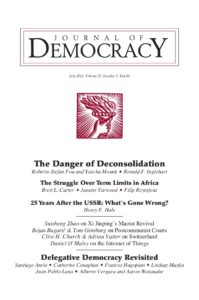 It is—as it has so often been in the past—once again fashionable to project, in the words of the Financial Times, that “the future belongs to the left,” notes Yascha Mounk, an Associate Professor at Johns Hopkins University, a Senior Fellow at the German Marshall Fund, and the author of The People vs. Democracy: Why Our Freedom Is in Danger and How to Save It.
It is—as it has so often been in the past—once again fashionable to project, in the words of the Financial Times, that “the future belongs to the left,” notes Yascha Mounk, an Associate Professor at Johns Hopkins University, a Senior Fellow at the German Marshall Fund, and the author of The People vs. Democracy: Why Our Freedom Is in Danger and How to Save It.
At first sight, there are strong reasons for this conclusion, he writes for Democracy: A Journal of Ideas:
 In most Western democracies, left-leaning parties enjoy comfortable majorities among the youngest cohorts of voters. Demographic groups that tend to support the left, from ethnic and religious minorities to the residents of large cities, are continuing to grow. Finally, a new set of left-of-center parties is rapidly rising, and seems poised to take on the reins of government within the next years or decades.
In most Western democracies, left-leaning parties enjoy comfortable majorities among the youngest cohorts of voters. Demographic groups that tend to support the left, from ethnic and religious minorities to the residents of large cities, are continuing to grow. Finally, a new set of left-of-center parties is rapidly rising, and seems poised to take on the reins of government within the next years or decades.
Even so, a closer analysis of recent transformations on the left suggests a far more skeptical conclusion. Social democratic and far-left parties are failing to attract a large or cohesive share of the electorate. The rise of green and liberal parties cannot compensate for their weakness. For now, no left-wing movement seems capable of—or even especially intent on—appealing to some of the voting block who had once been their most loyal supporters.
The strange predicament of today’s left is that it is both too pessimistic and too presumptuous. Even as some left strategists insist that they can deal a fatal blow to capitalism, many of them seem content to give up on much of its traditional electorate. And even though many of them believe that demographic changes will hand them an automatic majority, especially in the United States, they envisage a future in which a person’s skin color will be an excellent predictor of their partisan identity.
For all of these reasons, it is time for the left to become less triumphalist and more optimistic. It remains possible to build a left majority, adds Mounk, a contributor to the NED’s Journal of Democracy. But to do so, left-of-center parties need to speak both to the rising segment of urban, cosmopolitan voters and to their traditional base.







